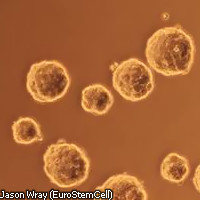Stem cells self renew, reveals study
Researchers from the EU-funded EuroStemCell project have shown for the first time that mouse embryonic stem cells are able to self-renew without the natural culture materials that scientists have so far used to maintain them and grow stem cell lines. This discovery, which was recently published in the journal Nature, contradicts previously-held views and could have wide-ranging implications for stem cell research. Mouse embryonic stem cells are derived and grown using various combinations of culture materials such as feeder cells, conditioned media, hormones and serum extracts. Previously, it was believed that these materials provided the signals and instructions to stem cells to maintain their undifferentiated 'blank' state. Without these materials, it was thought that stem cells would specialise to become whatever type of cell they were prompted to become. Cells still need to be grown in a culture giving them the sugars and proteins needed to stay alive. However, the researchers were able to show that embryonic stem cells produce their own signalling molecules and that these signals are the key driving force behind differentiation. When one of the cells' own signalling molecules, FGF (Fibroblast Growth Factor) 4, is eliminated or blocked, the cells can remain in their undifferentiated state indefinitely, the researchers discovered. They demonstrated this by applying small molecules that would block the action of FGF4. 'That ES [embryonic stem] cells can self-replicate without external instruction implies that they are intrinsically programmed to self-renew. The new culture conditions will help us to understand the nature of the pluripotent state and how it might be manipulated to produce specialised cells in the laboratory,' explains, Jason Wray of the Wellcome Trust Centre for Stem Cell Research, and one of the authors on the paper. The research is expected to be useful for the derivation of embryonic stem cells from other animals. 'We believe the process we discovered in mice may facilitate the derivation of embryonic stem cells from species like pigs, cows or other large animals, which have not been done before,' Qi-Long Ying, the lead author of the paper and now assistant professor of cell and neurobiology at the University of Southern California (USC). 'If deriving embryonic stem cells from cows, for instance, is possible, then perhaps in the future cows might be able to produce milk containing medicines.' A better understanding of what controls differentiation in mouse embryonic stem cells should also allow the work that has so far taken place only with mouse embryonic stem cells to be replicated in human embryonic stem cells. 'Last year it was shown that established human 'ES' cells are more similar to mouse 'Epi-stem cells', which correspond to a later stage of development. We have reason to believe that what we have observed in mice will read across to other mammals and that the new culture conditions we have established may allow us to transfer our experience and techniques from animal models to human,' explains Mr Wray. The discovery is expected to have major implications for large scale production of specialised cells, such as brain, heart muscle and insulin producing cells, for future therapeutic use.



